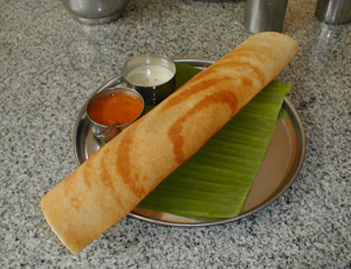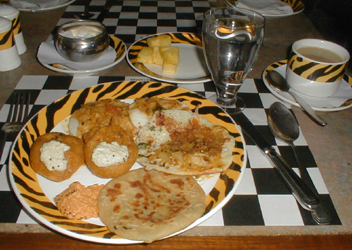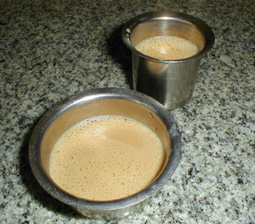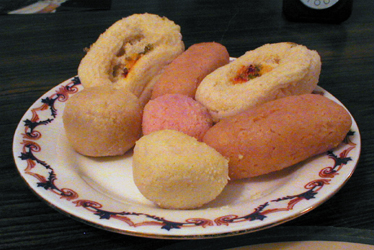
Here in the South, the meal revolves around rice with the accompaniment of dal (a bean porridge with many variations) and other vegetables. Most of the citizens are strictly vegetarian. Often the locals can be seen eating without utensils of any kind, even when the meal is a soupy blend of rice and assorted soupy extras. For added local color, you may be served a meal from a fresh banana leaf.
Specialty snacks available only in the South include dosa (a
large crisp pancake filled with any number of ingredients), idlli
(a thick spongy pancake made from rice), and vada (a donut-shaped
deep-fried puffy bread), and they are available everywhere on the street.

In contrast, a typical southern India breakfast can include a porridge
(uppama) or a selection of idlli and vada. There
is always a side dish of sambar (a thin vegetable broth with lots
of onion and spices) and often some coconut chutney to go along with it.
I have seen lots of cafes around town where the the locals grab a few idlli
and vadas on their way to work.


Coffee is a favorite here, served with hot milk and sugar. They will bring black coffee if you insist, but you will get some strange looks. Very often the coffee here is made from a combination of coffee beans and chickory, just like in New Orleans. Tea (chai) is available, also served with lots of hot milk and sugar. Both beverages are commonly served in a stainless steel demi-tasse style cup, set in a second shallow stainless bowl (sorta a cup and saucer arrangement). The technique for cooling your coffee is to pour the contents from the cup into the bowl and back again. Unusual, but it works.
The meals are served buffet-style. First you pick up a one-foot diameter stainless steel thali with inch-high straight sides (useful for keeping the food on the plate!) and several small stainless straight-sided bowls to hold the soupy items. There is usually one dal or a similar bean dish, a dry curry of vegetables such as cabbage or beans, a flavored rice (pilao) and lots of white rice. There's usually a variety of flatbread (the generic name is roti) such as nan, paratha, chapati, or puri. Most everyone adds a bowl of sambar to spice up the rice and a bowl of rasam, a curious concoction of water, peppers and onions boiled into a very thin soup. I have been encouraged to drink rasam with every meal to aid digestion, even when it seemed like the last thing I wanted. There's also a big bowl of homemade curd, a thin yogurt (also for digestion) that does seem like a good thing to eat after a plateful of spicy curries, dal, sambar, and rice. Just to add crunch to the meals, there's often papad (a.k.a. papadum) which are delightful paper-thin snacks, but beware, some varieties are laced with "a-hoo-ah" peppers.
It is interesting to me that Indians don't often drink beverages with their meal. They wait until they are finished, then stop by the water cooler and down a glass or two.
At least in our neighborhood, there are restaurants where one can sample chicken and lamb ("non-veg") specialties, though most restaurants you see around the city advertise "veg" only. Some of my colleagues at Honeywell told me that they prefer not to go into a restaurant that serves meat, because the utensils and plates have been used to serve non-veg food. Similar to the kosher concept of separate services for dairy and meat, I guess.
We had one meal at a restaurant at the Gateway Hotel in Bangalore that serves cuisine from Kerala, the coastal state that is south and west from here. This food was totally different than typical Bangalore fare, dominated by coconut and many kinds of fish and shellfish. Unfortunately, I was in the middle of a serious bout with an intestinal bug during that visit, so I will have to go back to try this place again.
We actually went to Pizza Hut twice so far (gasp!). Not because the pizza was so great there; it was only OK. It just seemed like a simple safe meal at the time, and it was a five minute walk to the restaurant. And where in the USA can you get a chili pepper and paneer cheese pizza?
The other beverages that are popular here are fresh lime soda (either salty or sweet) and lassi, sort of a yogurt smoothie, again served either salty or sweet. I can't comprehend why one would want a salty lime or yogurt drink, but I will probably try it one of these days, just to say I had one. I know the regular sweet lime sodas taste terrific.

Diane and I did discover a European-style bakery at the top of the local German cultural center, the Max Mueller Bhavan. They don't serve great German pastry, but the strudel isn't half bad and a welcome change from squeaky balls of cooked milk!